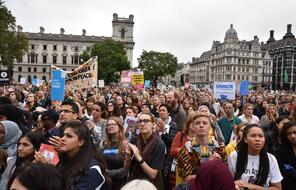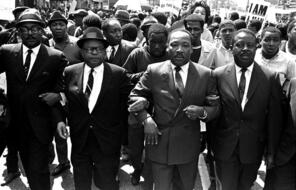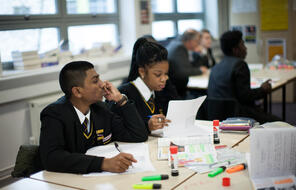Voting Rights in the United States
At a Glance
Language
English — USSubject
- Social Studies
- Democracy & Civic Engagement
Excerpt 1
For Some Native Americans, No Home Address Might Mean No Voting (Pew)
At the end of a labyrinth of red dirt roads and surrounded by the rusty cliffs of nearby mesas, Marthleen and Shuan Stephenson live on an isolated desert homestead on the sprawling Navajo Nation [in Utah].
Until last month, you couldn’t find their home using a traditional address. Instead, the directions went like this: “Turn off U.S. Highway 191 between mile markers 1 and 2. It’s a blue house with a tan roof.”. . .
Like the Stephensons’, most homes on the Navajo Nation in southeastern Utah lack street addresses. That means packages must be shipped to businesses or relatives who live in town, many miles away. Most on the reservation get their regular mail at post office boxes, which are sometimes located in Arizona. Emergency responders, given vague home locations, are often delayed.
But it is the impact on voting that has many indigenous rights advocates deeply concerned.
“In Indian Country, you don’t have a 123 Elm Street address,” said James Tucker, a pro bono voting rights counsel for the Native American Rights Fund.
“It limits your gateway to even be able to register to vote, to putting your foot through the door to participate from the get-go.”
County by county, election administrators must know exactly where voters live to assign accurate precincts, which then determine which ballot a voter receives, which offices she votes for and at which polling location she casts a ballot. In Utah and many other largely rural states, residents can register to vote by describing their approximate location on registration forms, or even draw a rudimentary map, which is allowed by the National Voter Registration Act of 1993.
But in states with strict voter identification laws, officials typically require a traditional address . . .
In 2012, election officials in Apache County, Arizona, purged 500 Navajo voters from the registration system, claiming their addresses were “too obscure,” according to a field study by the Native American Rights Fund . . .
Four Directions [an organization that works to advance voting rights in Indian Country] worked with the Standing Rock Sioux Reservation in North Dakota to create an emergency addressing system just a few days before the 2018 elections. After about 20 tribal members pointed to their residences on a map, Four Directions assigned new addresses that fit the state’s new standard and were officially notarized by the tribe. In other tribes in the state, leaders helped print new tribal IDs that met the state’s requirements. 1
- 1Matt Vasilogambros, “For Some Native Americans, No Home Address Might Mean No Voting," The Pew Charitable Trusts, October 4, 2019.
Excerpt 2
Why Do Nonwhite Georgia Voters Have To Wait In Line For Hours? Too Few Polling Places (NPR)
Kathy spotted the long line of voters as she pulled into the Christian City Welcome Center about 3:30 p.m., ready to cast her ballot in the June 9 [2020] primary election.
Hundreds of people were waiting in the heat and rain outside the lush, tree-lined complex in Union City, an Atlanta suburb with 22,400 residents, nearly 88% of them Black. She briefly considered not casting a ballot at all, but decided to stay.
By the time she got inside more than five hours later, the polls had officially closed and the electronic scanners were shut down. Poll workers told her she'd have to cast a provisional ballot, but they promised that her vote would be counted.
"I'm now angry again, I'm frustrated again, and now I have an added emotion, which is anxiety," said Kathy, a human services worker, recalling her emotions at the time. She asked that her full name not be used because she fears repercussions from speaking out. "I'm wondering if my ballot is going to count."
By the time the last voter finally got inside the welcome center to cast a ballot, it was the next day, June 10.
The clogged polling locations in metro Atlanta reflect an underlying pattern: the number of places to vote has shrunk statewide, with little recourse. Although the reduction in polling places has taken place across racial lines, it has primarily caused long lines in nonwhite neighborhoods where voter registration has surged and more residents cast ballots in person on Election Day . . .
The growth in registered voters has outstripped the number of available polling places in both predominantly white and Black neighborhoods. But the lines to vote have been longer in Black areas, because Black voters are more likely than whites to cast their ballots in person on Election Day and are more reluctant to vote by mail, according to U.S. census data and recent studies. Georgia Public Broadcasting/ProPublica found that about two-thirds of the polling places that had to stay open late for the June primary to accommodate waiting voters were in majority-Black neighborhoods, even though they made up only about one-third of the state's polling places. An analysis by Stanford University political science professor Jonathan Rodden of the data collected by Georgia Public Broadcasting/ProPublica found that the average wait time after 7 p.m. across Georgia was 51 minutes in polling places that were 90% or more nonwhite, but only six minutes in polling places that were 90% white. 1
- 1Stephanie Fowler, “Why Do Nonwhite Georgia Voters Have To Wait In Line For Hours? Too Few Polling Places," NPR, October 17, 2020.
Excerpt 3
For Many Young Texans, Getting An ID Is One Of The Biggest Obstacles To Voting (Houston Public Media)
Ana Flores can vote for the first time this year. The 18-year-old lives in Houston with her mom. Like many young people who just got the right to vote, she was curious about what it would be like.
"I just wanted to try it out,” she said, “see how it would feel for the first time." Flores was registered to vote and aware of some of the races on the ballot; she said she was particularly excited about voting in the U.S. Senate race. But there was a big thing standing in the way of her actually voting: the Texas voter ID law requiring her to show a state-issued identification at the polls.
Flores said she had had trouble getting an ID from the Texas Department of Public Safety before.
"I went up there just one time when I was about, I think, 16 or 17," she said. "But we'd go back like three times–back home, go back, back home, go back. So, I just didn't try again."
Flores didn't have the proper documents to prove she was a resident of Texas. She knew she’d have to try again if she wanted to vote this year. Luckily for her, a group called Spread the Vote started reaching out to students at her school.
"Our focus is to make sure they have the ID so that they can actually vote," said Christina Sanders, state director for Spread the Vote.
Spread the Vote has been in Texas since May. Sanders said the group is helping populations who have the hardest time getting IDs, including the homeless population and students.
"It is extremely challenging if you are 17 and eight months eligible to vote, or 18, and you don't have a light bill in your name,” she said, “and you don't have a bank account in your name, or lease in your name to be able to establish yourself as a Texas resident.”
Sanders said this is also really hard for college students–particularly out-of-state college students.
The list of IDs allowed at the polls is limited. While a handgun license, military ID or U.S. passport are allowed, for example, a student ID is not. 1
- 1Ashley Lopez, “For Many Young Texans, Getting An ID Is One Of The Biggest Obstacles To Voting," Houston Public Media, November 5, 2018.













